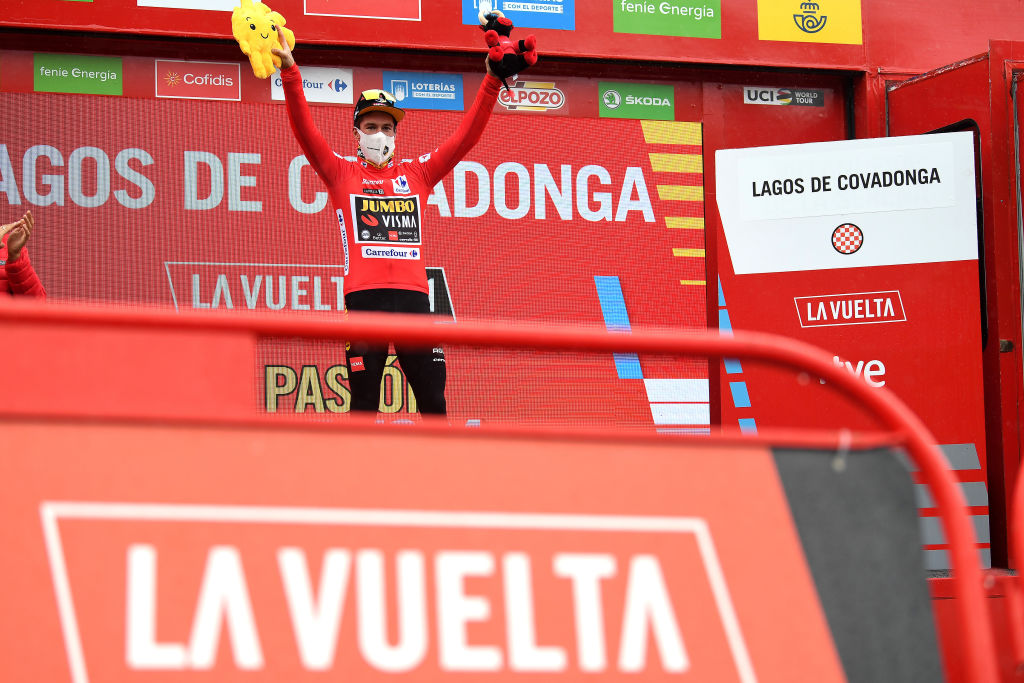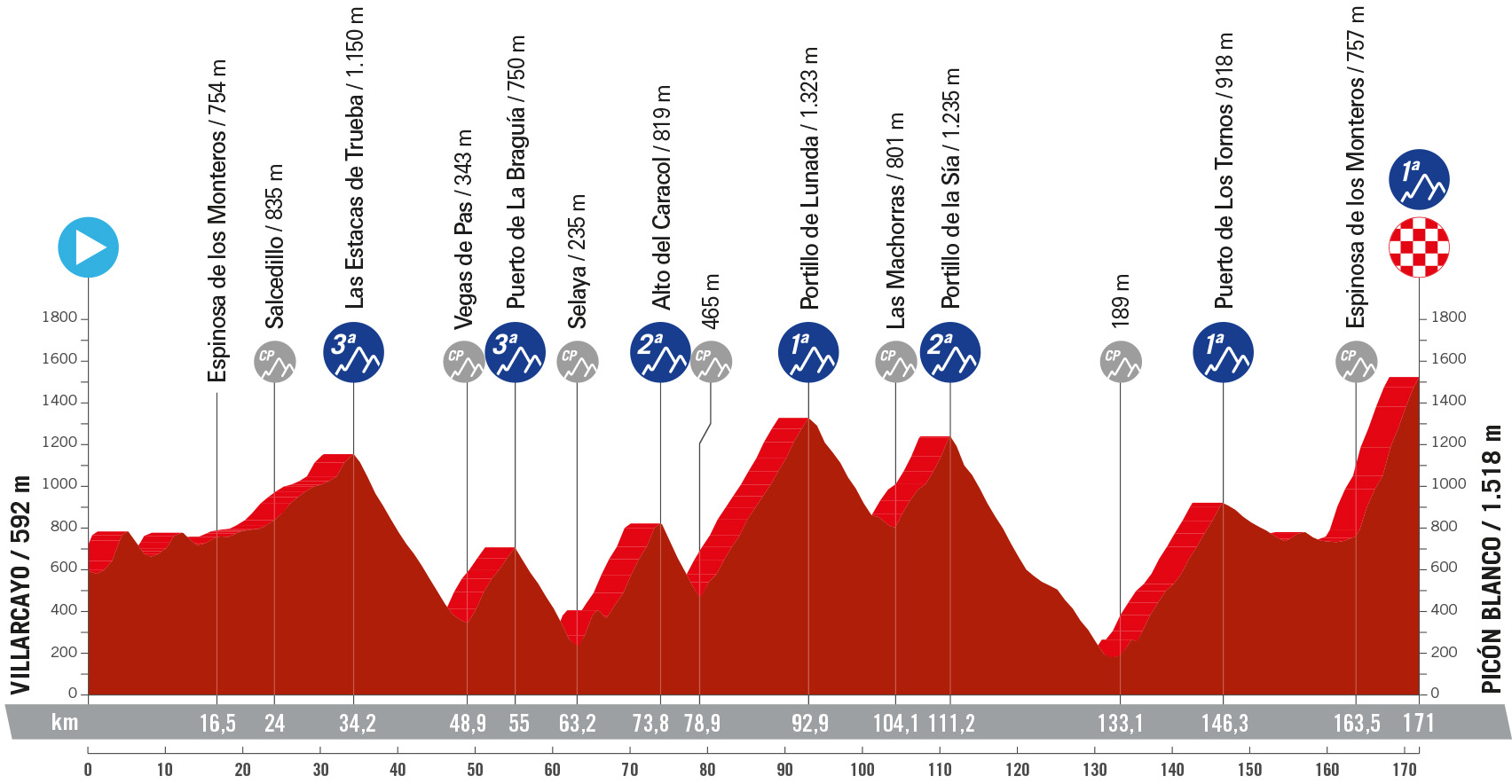
After an edition of the Vuelta a España in 2023 which included mountain-top finishes with the emblematic status of the Tourmalet and the Angliru, designing a 2024 route to live up to last year's glittering standards was always going to be a difficult ask for race organisers Unipublic.
But as race boss Javier Guillén put it on Tuesday evening’s race presentation of the 2024 Vuelta route, by sticking to their usual strategy of mixing tradition - in this case multiple summit finishes - with innovations like reviving the flat final day time trial, he believes they have found the perfect way of ensuring the race continues to remain as attractive and intriguing as ever to both spectators and riders.
A spectacular start in the Portuguese capital of Lisbon with a time trial alongside the mighty River Tagus will certainly make for a memorable opening stage. And after the return to Spain, the challenges come thick and fast. There is a first summit finish on stage 4, and plenty of rugged terrain for the breakaways, tough mountain stages both in the deep south and the remote northwest, and a respectable number of flat stages - six - for the sprinters.
Here is Cyclingnews' take on the five key GC stages of next year’s race - although as Sepp Kuss proved at Javalambre last year, if there’s one Grand Tour where opportunities to go for the win always appear at almost any point in the entire route, it’s the Vuelta a España.
Stage 9
Sunday August 25: Motril to Granada, 178km

If anybody knows why the GC contenders should be worried about stage 9 of the 2024 Vuelta a España, it’s former pro Alejandro Valverde. Back in 2006, on exactly the same last, long descent from Sierra Nevada down to Granada that will feature in the finale of the 2024 stage, race leader Valverde was tracking his closest GC pursuer Alexander Vinokourov. Somehow, perhaps being undergeared, he lost the Kazakh’s wheel - and with it, as the gap stretched wider and wider between the two, the Vuelta itself.
Coming at the end of the first, long week of the 2024 Vuelta rather than the middle of the third like in 2006, next year’s contenders can take comfort that if they make any errors or suffer time losses on that day, they will have plenty of opportunities down the line to get back into the GC fight.
On the other hand, the route for the 2024 stage through Sierra Nevada and down to Granada is much tougher than in 2006, and the chances of even bigger time losses than Valverde in 2006 therefore much greater.
The Alto del Purchil - also tackled that day in 2006 - is the first of three category 1 ascents on stage 9, but it's what follows that arguably counts the most. The brutally steep, narrow and twisting ascent of Hazallanas, tackled twice in rapid succession after the Purchil, is likely where the most serious damage will be done.
The chances of blisteringly hot weather in Granada in late August are also very high indeed - temperatures in enclosed mountain valleys such as the one that leads to Hazallanas regularly reach the mid-40s in August, which will just make the suffering even worse. Furthermore, Hazallanas was where USA’s Chris Horner struck his first major blow towards winning the Vuelta in 2013 and it could prove just as important in 2024.
Stage 15
Sunday September 1: Infiesto to Cuitu Negru, 142km

Without a doubt, one of the four hardest days of climbing in the entire 2024 Vuelta a España is stage 15. The tarmacked ski slopes of the upper reaches of the Cuitu Negru were last tackled as long as 12 years ago in the Vuelta. But their unremitting steepness, with gradients up to 24% for stretches of several hundred metres at a time and riders weaving wildly from side to side as they tried to tackle them, remain etched in the collective memory of the race's fans.
There’s always a lot of debate about whether tackling climbs that are more like riding up the side of a house can actually be the best place to create major differences on GC. After all, ascents as steep as the Cuitu Negru - very similar in difficulty to the Angliru, situated just a few kilometres away - are so hard riders are at a near standstill as they grind up the climb and the opportunities to accelerate are very limited.
Fortunately for the GC battle, Cuitu Negru only gets so tough right at the top, given its first part consists of a lengthy former category 1 climb, the Pajares, which in times gone by featured regularly in the Vuelta. The Pajares alone was tough enough for, say, Roberto Heras to inflict a stinging defeat on previous leader Denis Menchov in the 2005 race and effectively win it outright. Add in Cuitu Negru and an early attack where the climbing's more straightforward, then consolidated on the harder upper slopes, could pay real dividends.
Furthermore, while the climb ‘proper’ of Cuitu Negru is 19 kilometres long, the riders will be climbing for a staggering 41 kilometres, from 240 metres to 1,392 metres above sea level. Factor in two ascents of the Colladiella even before they reach the foot of Cuitu Negru, not to mention the chances - always high in Asturias - of rough weather, and stage 15 will likely see a major battle for the overall unfold long before the hardest part of the climb.
Stage 16
Tuesday September 3: Luanco to Lagos de Covadonga, 181km

The seventh of nine summit finishes in the 2024 Vuelta a España, Lagos de Covadonga is one of the race’s best-known and best-loved ascents, and next September when the Vuelta peloton tackles it for a 23rd time, for fans and race followers alike it will be one of the most keenly anticipated stages of the entire 2024 event.
Widely ranked as Spain’s toughest single climb prior to the discovery of the Angliru in 1999, Lagos de Covadonga has very special characteristics. Set deep in the Picos de Europa mountain region, and like the wild wolves that have famously roamed across much of the area for centuries, Lagos de Covadonga has developed a well-earned reputation for being a tough, somewhat unpredictable, beast to tackle, with a fierce bite if approached too confidently.
Much of its difficulty and unpredictability centres not just on its three really tough segments - the Mirador del Canonigos, the Huesera and the Mirador de la Reina - but also on how wildly the climb's gradient varies. Even for those who know the climb well, those constant changes of pace make it extraordinarily difficult to calculate the balance between a high enough speed and cracking. Come the summit, the consequences of that calculation can lead to a stunning victory, or a serious time loss - and in a year when Covadonga follows a rest day, always apt to have a knock-on effect for better or worse on riders, even more so.
Much like Alpe d‘Huez - to which it was compared by 1983 Vuelta winner Bernard Hinault - legend has it that the rider in the lead in Lagos de Covadonga will triumph in the Vuelta outright in Madrid. Next year, that doesn’t seem so much of a given, as there are three key GC stages still to come after Covadonga, although it was true for Primož Roglič when he triumphed on the climb in 2021, the last time it was tackled by the men's race, and nearly a week before his final victory in Santiago de Compostela.
But whoever swoops down past the pristine waters of Covadonga lake next September to raise their arms on the final, short rise to the finish, the prestige of clinching such an outstandingly difficult climb to conquer will surely endure just the same.
Stage 20
Saturday September 7: Villarcayo to Picón Blanco, 171km

The last mountain stage of the 2024 Vuelta a España is, on paper, by far the most decisive. Not just because of its position in the race, barely 24 hours before the grand finale in Madrid, but also because of its jaw-dropping difficulty.
As UAE Team Emirates Joxean Fernández Matxin pointed out, stage 20's seven classified ascents will likely total around 5,000 metres of vertical climbing, which is harsh enough so late in the race. What's even more daunting, though, is the way that the stage 20 route gets steadily harder, with three first category ascents and a category 2 packed into the last 90 kilometres.
A familiar climb in the Vuelta a Burgos, Picón Blanco has only featured as a summit finish once in the Vuelta a España, back in 2021 when Rein Taaramae took the opening mountain stage. The strong headwinds that day severely limited the GC riders' room for manoeuvre. But in 2024, with nothing to lose and a time trial looming on the last Sunday, the odds that somebody could attack on one of the earlier climbs and try to blow the race apart from distance are high.
For whichever rider is in the lead, too, Picón Blanco will be as much as test of their team’s collective climbing strength as their individual capabilities. But if there are any signs of weakness on their part, then the course of the whole race could abruptly change direction, almost at the last possible moment.
Stage 21
Sunday September 8: Madrid to Madrid 22km (individual time trial)

Given last year’s final stage through the streets of Madrid was one of the most dramatic of the entire Vuelta, it's not a little ironic that one widely-touted reason for shifting the main ITT of 2024 from a more usual mid-race slot to the last moments of the Vuelta is, in theory, to keep the emotion as high as possible all the way to the final line.
Back in 2023's stage 21, after Jumbo-Visma had steamrolled the opposition out of existence on the slopes of the Tourmalet eight days earlier, the GC battle was long since decided. But the drawnout struggle last September in the streets of Madrid between stage winner Remco Evenpoel (Soudal-QuickStep), Filippo Ganna (Ineos Grenadiers) and the 2023 Vuelta’s top sprinter Kaden Groves (Alpecin-Deceuninck), amongst others, just metres ahead of the peloton for nearly 30 kilometres made for a thrilling finale.
In any case, the 2024 Vuelta has opted for an almost totally flat, final time trial through the streets of Madrid. Even if the race has been decided by then, at the least it will act as a fine homage to the overall leader.
In the most dramatic of cases, it could see a last minute turnaround - as happened on the previous final TT through the Spanish capital way back in 2002, when Aitor Gonzalez outpaced longstanding leader Roberto Heras for the biggest victory of his career. Now 22 years later on the same roads, could that historic upsetting of the Vuelta's GC applecart be repeated again?








